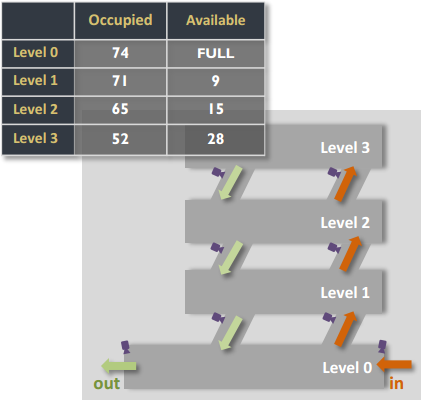
intuVision VA offers two primary options for obtaining the occupancy of a surface parking lot or parking garage, spot-based and count-based.
Spot-Based Occupancy: this entails using analytics on each parking space of a surface lot or parking garage. While more cameras are sometimes needed to obtain a clear view of each spot, this can give more nuanced information relating to the parking garage, including exactly which parking spots are open, park durations for each vehicle, and (if needed) alerts on if vehicles are parking over-long.
Count-Based Occupancy: this entails cameras positioned at each entrance and exit, and using intuVision VA to count the vehicles as they enter a surface lot, parking garage, or each floor of the parking garage. This is often a lower cost deployment option as fewer cameras are needed, but includes some limitations in the type of available data.
While both methods of deployment require specific camera placement, the difficulty in obtaining the optimal camera view will depend on the environment and your flexibility in camera mounting.
For spot-based occupancy, the software will require a clear, unobstructed view of each parking spot of interest, in order to track if there is a vehicle present. For outdoor, surface lots, this is typically fairly simple, depending on access to large structures or lighting poles. A fairly standard camera view for an outdoor lot covers 25-45 spaces, depending on layout and camera height. For indoor parking garages, this can be more difficult, due to low ceiling height. Depending on ceiling height and layout, 5-10 spots can typically be covered by one camera.
For count-based occupancy, the software will require a clear, ideally top-down view of vehicles entering and leaving the garage or floor. For outdoor, surface lots, this can sometimes be difficult, depending on what mounting locations are available. For parking garages, this is typically fairly simple, as a camera mounted on the ceiling above the entrances and exits will have a perfect view.
While both methods have high accuracy benchmarks, typically the spot-based occupancy will have slightly higher accuracy. This is due primarily to its ability to consistently adjust to any false detection, i.e. detections are constantly being performed on each parking spot. For count-based occupancy, while there are algorithms in place to compensate for this, if an entrance or exit is miscounted, this will not be rectified until the counts are reset.
An 8 hour long test of a parking lot, using the spot-based occupancy yielded a 96% accuracy, a test of the count-based analytics on the same 8 hour set of data yielded slightly lower accuracy.
Spot-based occupancy offers more information for the parking area in general, as well as more insight into individual customer behavior, whereas count-based simply provides a count and a percentage based estimate of how many parking spots remain.
The information provided by spot-based occupancy includes: